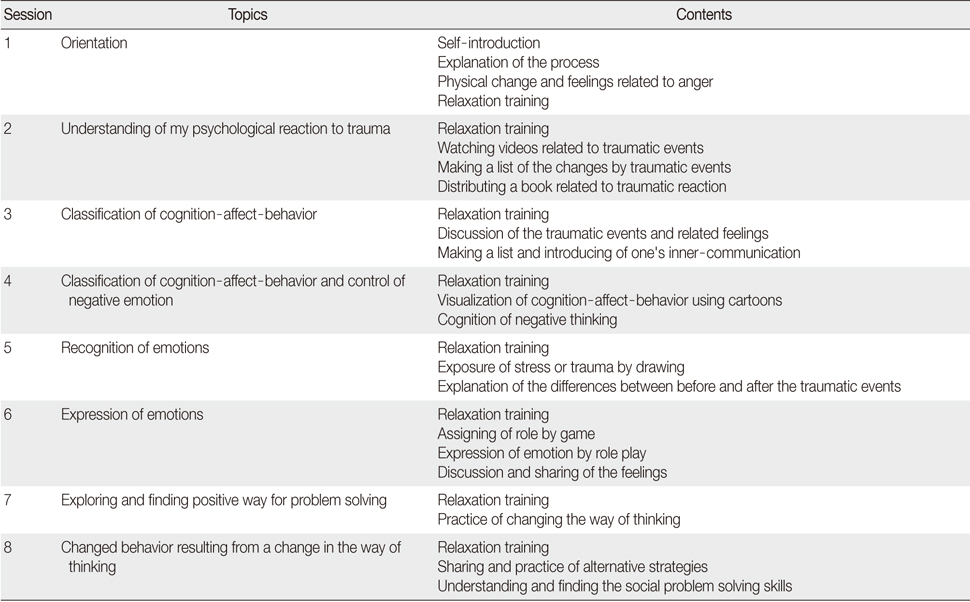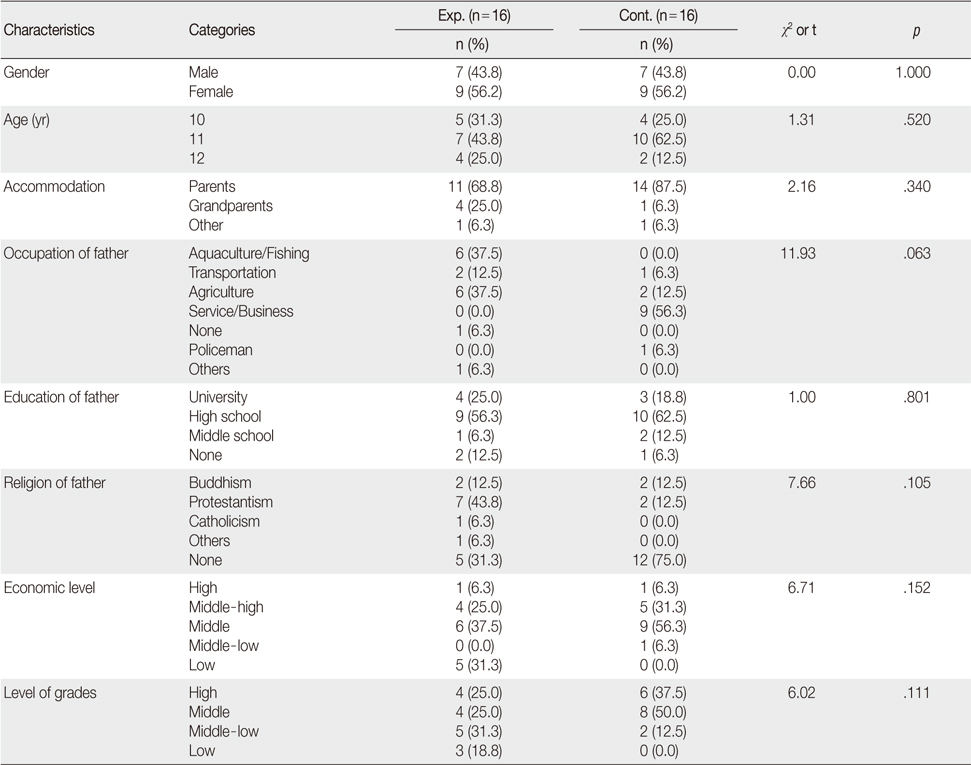Articles
- Page Path
- HOME > J Korean Acad Nurs > Volume 42(1); 2012 > Article
-
Original Article
- Effects of Cognitive Behavioral Therapy Program on Mental Health Problems in Children Dealing with Trauma: Focused on Community District Victimized by Oil Spill
- Jung Nam Sohn, Yong-Mi Lee
-
Journal of Korean Academy of Nursing 2012;42(1):56-65.
DOI: https://doi.org/10.4040/jkan.2012.42.1.56
Published online: February 29, 2012
1Professor, Department of Nursing, Hanseo University, Seosan, Korea.
2Assistant Professor, Department of Nursing, Kangwon National University, Chuncheon, Korea.
- Address reprint requests to: Lee, Yong-Mi. Department of Nursing, Kangwon National University, 192-1 Hyoja-dong, Chuncheon 200-701, Korea. Tel: +82-33-250-8889, Fax: +82-33-242-8840, rena@kangwon.ac.kr
© 2012 Korean Society of Nursing Science
- 762 Views
- 3 Download
- 4 Crossref
Abstract
-
Purpose
- This study was done to evaluate the effects of cognitive behavioral therapy in a victimized community district and to determine if the program is an effective nursing intervention to reduce posttraumatic stress disorder symptom, depression and state anxiety.
-
Methods
- A nonequivalent control group design was used for the study. The participants, 32 elementary school students, were selected from grades 4, 5, 6 and each student was assigned to either the experimental (16) or control (16) group. Cognitive behavioral therapy was used as the experimental treatment from April 9 to May 28, 2009. The experimental group received cognitive behavior therapy intervention 8 times. Data analysis was done using ANCOVA with SPSS 17.0.
-
Results
- After the intervention, the experimental group showed significantly lower levels of posttraumatic stress disorder symptoms than the control group.
-
Conclusion
- The findings from this study suggest that cognitive behavioral therapy is an effective nursing intervention to decrease the level of mental health problems of children in victimized district. Further research is required in order to identify the continuous effects of cognitive behavioral therapy.
- 1. Briere J., Elliot D. Prevalence, characteristics, and long-term sequelae of natural disaster exposure in general population. Journal of Traumatic Stress. 2000;13:661–679. http://dx.doi.org/10.1023/A:1007814301369.ArticlePubMed
- 2. Chang J.S. A case study of art therapy on anxiety of child with post-traumatic stress disorder. 2007;Asan, Shunchunhyang University. Unpublished master's thesis.
- 3. Cho S.C., Choi J.S. Development of the Korean form of the state-trait anxiety inventory for children. Seoul Journal of Psychiatry. 1989;14:150–157.
- 4. Cho S.C., Lee Y.S. Development of the Korean form of the Kovacs' Children's Depression Inventory. Journal of Korean Neuropsychiatric Association. 1990;29:943–956.
- 5. Choi J.Y., Shin Y.J., Oh K.J. Effectiveness of trauma-focused cognitive behavioral therapy for sexually abused children: An exploratory study. Cognitive Behavior Therapy in Korea. 2009;9(1):57–73.
- 6. Choi N., Byun J., Han D., Im S.B. Psychological impact and depressive response of sufferers of natural disaster, a torrential downpour. Journal of Korean Academy of Psychiatric and Mental Health Nursing. 2007;16:139–149.ArticlePDF
- 7. Cohen J.A., Jaycox L.H., Walker D.W., Mannarino A.P., Langley A.K., DuClos J.L. Treating traumatized children after Hurricane Katrina: Project Fleur-de Lis. Clinical Child and Family Psychology Review. 2009;12:55–64. http://dx.doi.org/10.1007/s10567-009-0039-2.ArticlePubMedPMCPDF
- 8. Frank E., Anderson B., Stewart B.D., Dancu C., Hughes C., West D. Efficacy of cognitive behavior therapy and systematic desensitizationin the treatment rape trauma. Behavior Therapy. 1988;19:403–420. http://dx.doi.org/10.1016/S0005-7894(88)80012-1.Article
- 9. Finkelhor D. The victimization of children: A developmental perspective. The American Journal of Orthopsychiatry. 1995;65:177–193. http://dx.doi.org/10.1037/h0079618.ArticlePubMed
- 10. Ha E.H., Oh K.J., Song D.H., Kang J.H. The effects of cognitive-behavioral group therapy for depression and anxiety disorders in adolescents: A preliminary study. Korean Journal of Clinical Psychology. 2004;23:263–279.
- 11. Ha M.N. Health impact on residences, volunteer, and children. Paper presented at the meeting of the Taean Environmental Health Center. 2008;09;Taean.
- 12. Jaycox L., Stein B., Kataoka S., Wong M., Fink A., Escudera P., et al. Violence exposure, posttraumatic stress disorder, and depressive symptoms among recent immigrant schoolchildren. Journal of the American Academy of Child and Adolescent Psychiatry. 2002;41:1104–1110. http://dx.doi.org/10.1097/00004583-200209000-00011.ArticlePubMed
- 13. Jaycox L. CBITS: Cognitive behavioral intervention for trauma in schools. 2004;Longmont, CO, Sopris West Educational Services.
- 14. Kim S.H., Kim C.K. The effect of interpersonal psychotherapy for group and cognitive-behavioral therapy for group on depression and related variables in adolescents. Korean Journal of Youth Studies. 2010;17(3):55–86.
- 15. Kim S.Y. A study of PTSD symptom and related factors of the railroad drivers with the experience of "Person under Train" accidents. 2010;Busan, Dong-A University. Unpublished master's thesis.
- 16. Kim S.J., Kim W. Posttraumatic stress. 2000;Seoul, HakJisa.
- 17. Kovacs M. The children's depression inventory: A self-rated depression scale for school-aged youngsters. 1983;Pittsburgh, PA, University of Pittsburgh.
- 18. La Greca A., Silverman W.K., Vernberg E.M., Prinstein M.J. Symptoms of posttraumatic stress in children after Hurricane Andrew: A prospective study. Journal of Consulting and Clinical Psychology. 1996;64:712–723.ArticlePubMed
- 19. Lee J.S., Han Y.S. Effect of cognitive behavior therapy program in child with posttraumatic stress disorder. Korean Journal of Human Ecology. 2006;9(2):21–31.
- 20. Leon G.R. Overview of the psychosocial impact of disasters. Prehospital and Disaster Medicine. 2004;19:4–9.ArticlePubMed
- 21. Moser J.S., Hajcak G., Simons R.F., Foa E.B. Posttraumatic stress disorder symptoms in trauma-exposed college students: The role of trauma-related cognitions, gender, and negative affect. Journal of Anxiety Disorders. 2007;21:1039–1049. http://dx.doi.org/10.1016/j.janxdis.2006.10.009.ArticlePubMedPMC
- 22. Muris P., Mayer B., den Adel M., Roos T., van Wamelen J. Predictors of change following cognitive-behavioral treatment of children with anxiety problems: A preliminary investigation on negative automatic thoughts and anxiety control. Child Psychiatry and Human Development. 2008;40:139–151. http://dx.doi.org/10.1007/s10578-008-0116-7.ArticlePubMedPMC
- 23. Norris F.H., Friedman M.J., Watson P.J., Byrne C.M., Diaz E., Kaniasty K. 60,000 disaster victims speak: Part I. An empirical review of the empirical literature, 1981-2001. Psychiatry. 2002;65:207–239.ArticlePubMed
- 24. Picou J.S. Chronic psychological impacts Exxon Valdez oil spill: Resource loss and commercial fishers. Report presented for review to the Prince Williams Sound Regional Citizen's Advisory Council. 1997;Anchorage, Alaska.
- 25. Pine D.S., Cohen J.A. Trauma in children and adolescents: Riskand treatment of psychiatric sequelae. Biological Psychiatry. 2002;51:519–531. http://dx.doi.org/10.1016/S0006-3223(01)01352-X.ArticlePubMed
- 26. Pynoos R.S., Frederick C., Nader K., Arroyo W., Steinberg A., Eth S., et al. Life threat and posttraumatic stress in school-age children. Archives of General Psychiatry. 1987;44:1057–1063.ArticlePubMed
- 27. Seo H.J., Chae J.H. Recent cognitive behavioral therapy for posttraumatic stress disorder. Cognitive Behavior Therapy in Korea. 2006;6(2):117–129.
- 28. Seoul Child & Adolescent Mental Health Center. Mental health screening test scale book for child and adolescent community center. 2007;Seoul, Seoul Child & Adolescent Mental Health Center.
- 29. Sohn J.N. A study on PTSD, depression, anger and suicidal ideation after the hebei spirit oil spill in victimized community residence. Journal of Korean Academy of Psychiatric and Mental Health Nursing. 2008;17:411–420.
- 30. Spielberger C.D. Manual for the state-trait anxiety inventory for children. 1973;Palo Alto, CA, Consulting Psychologist Press.
REFERENCES
Figure & Data
REFERENCES
Citations

- Effects of Cognitive Behavioral Group Program for Mental Health Promotion of University Students
Soojung Lee, Eunjoo Lee
International Journal of Environmental Research and Public Health.2020; 17(10): 3500. CrossRef - A Descriptive Analysis of Long-Term Treatment with Adolescent-Aged Foster Youth
Saralyn Carola Ruff, Chloe L. Jones, June Madsen Clausen
Journal of Child & Adolescent Trauma.2019; 12(3): 331. CrossRef - Religion and mental health among Nepal earthquake survivors in temporary tent villages
Mikyung Jang, Ju-Ae Ko, Eun-jung Kim
Mental Health, Religion & Culture.2018; 21(4): 329. CrossRef - Effect of cognitive behavioural interventions on the quality of life in Chinese heroin‐dependent individuals in detoxification: a randomised controlled trial
Shu‐Mei Zhuang, Shi‐Hui An, Yue Zhao
Journal of Clinical Nursing.2014; 23(9-10): 1239. CrossRef
Contents of Cognitive Behavioral Therapy Program
Homogeneity Test for General Characteristics between Two Groups (N=32)
Exp.=Experimental group; Cont.=Control group.
Homogeneity Test for PTSD, Depression and State Anxiety before Cognitive Behavior Therapy between Two Groups (N=32)
PTSD=Posttraumatic stress disorder; Exp.=Experimental group; Cont.=Control group.
Comparison of Scores between Pretest and Posttest in the Two Groups (N=32)
PTSD=Posttraumatic stress disorder; Exp.=Experimental group; Cont.=Control group;
†ANCOVA with pretest value as covariate.
Exp.=Experimental group; Cont.=Control group.
PTSD=Posttraumatic stress disorder; Exp.=Experimental group; Cont.=Control group.
PTSD=Posttraumatic stress disorder; Exp.=Experimental group; Cont.=Control group; †ANCOVA with pretest value as covariate.
 KSNS
KSNS
 E-SUBMISSION
E-SUBMISSION




 Cite
Cite

